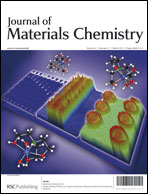We report several influential factors for achieving high fluorescent quantum yield and low ASE threshold from twin-tapered bi-1,3,4-oxadiazole derivatives by theoretical and experimental investigations. High fluorescence of BOXD-T3 in either apolar solvents or in the aggregating states were due to increased conjugation and a co-planar structure in the excited state, a four-level photophysical cycle between ground state and excited state, and co-planar formation of a rigid backbone with the tendency for slipped stacking. High fluorescence efficiency, high kr value, high σe value, polarized and self-waveguided emissions in BOXD-T3 solution processed aligned film contributed to the ultralow ASE threshold. Extremely strong fluorescence of the microbelt-like organogel BOXD-T3 with fluorescence quantum yield of near unity was achieved. This work paves the way toward obtaining highly fluorescent and ultralow-threshold ASE in an ordered solid state from bi-1,3,4-oxadiazole derivatives.
You have access to this article
 Please wait while we load your content...
Something went wrong. Try again?
Please wait while we load your content...
Something went wrong. Try again?


 Please wait while we load your content...
Please wait while we load your content...